Protecting accident victims for over 30 years
Experienced personal injury lawyers who are always on your side. We are dedicated to protecting your rights and livelihood.
START MY FREE CONSULTATION![Hot Car Deaths In Texas [2024]](https://www.bonillainjurylaw.com/wp-content/uploads/2024/05/Hot-Car-Deaths-In-Texas-2024.jpg)
*Note: This study was originally published on May 8th, 2024 and will be updated as necessary.
Summer is coming in Texas, which means one thing.
You need to be prepared for the heat.
Whether you like it or not, a UN Weather Agency report released in March 2024 stated that there’s a high probability that Summer 2024 is likely to be one of the hottest summers on record in Texas, being even hotter than the last.
Too often, when any parent is running an errand or doing a task, they will choose to leave their children in the car with the extreme heat outside. But most of these parents or guardians may not know that cars without air conditioning can heat up more than 20 degrees inside in as little as ten minutes.
Additionally, a child’s body heats up three to five times faster than an adult’s does, and an action as simple as cracking a window will do little to keep the car cool.
Out of the entire country, Texas leads the way in having the highest number of hot car fatalities since 1998, with a total of 144 deaths.
To access any part of the page, click any of the following links.
Using data from noheatstroke.org, a program supported by the National Safety Council, we compiled a list of every death that happened in a hot car from 1998 to the present.
With a total of 144 hot car deaths since 1998, there has been an average of 5.46 hot car deaths per year in Texas.
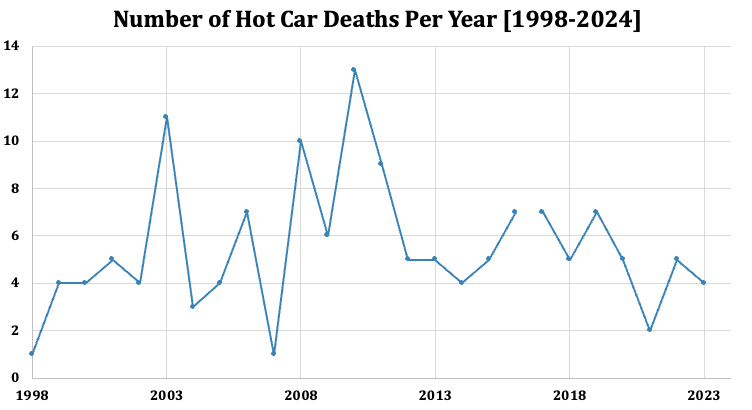
| Year | Deaths |
|---|---|
| 2023 | 4 |
| 2022 | 5 |
| 2021 | 2 |
| 2020 | 5 |
| 2019 | 7 |
| 2018 | 5 |
| 2017 | 7 |
| 2016 | 7 |
| 2015 | 5 |
| 2014 | 4 |
| 2013 | 5 |
| 2012 | 5 |
| 2011 | 9 |
| 2010 | 13 |
| 2009 | 6 |
| 2008 | 10 |
| 2007 | 1 |
| 2006 | 7 |
| 2005 | 4 |
| 2004 | 3 |
| 2003 | 11 |
| 2002 | 4 |
| 2001 | 5 |
| 2000 | 4 |
| 1999 | 4 |
| 1998 | 1 |
The amount of car deaths in Texas has stayed relatively consistent since 2013, as each year since then has had anywhere from 2 to 7 deaths. The state has averaged 5.5 deaths per year since 1998.
There’s also no additional explanation as to why there was a spike in hot car deaths from 2010, but according to multiple climate reports released at the time, 2010 was one of the hottest summers on record in the state, especially in Houston.
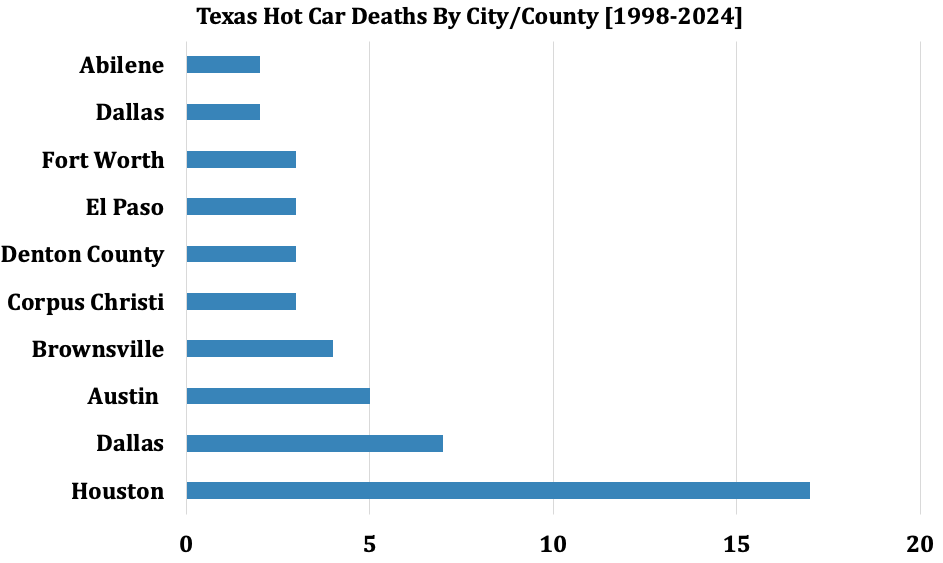
| City | Number of Deaths |
|---|---|
| Houston | 17 |
| Dallas | 7 |
| Austin | 5 |
| Brownsville | 4 |
| Corpus Christi | 3 |
| Denton County | 3 |
| El Paso | 3 |
| Fort Worth | 3 |
| Dallas | 2 |
| Abilene | 2 |
Austin, Dallas, and Houston have all had the most hot car deaths since 1998, with Houston having a total of 17 deaths.
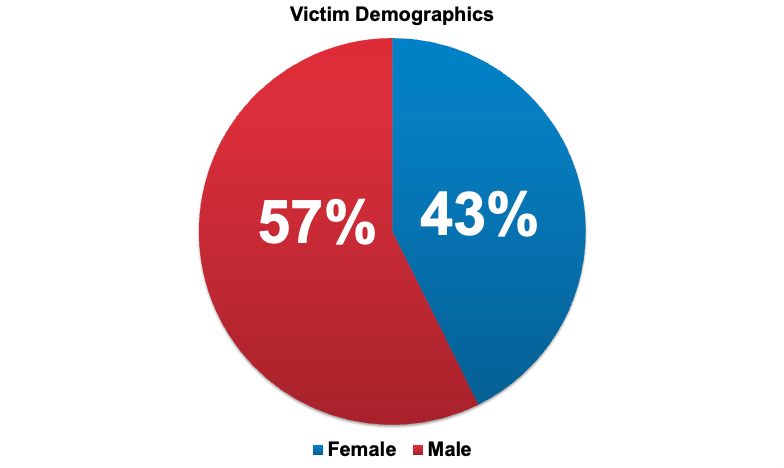
| Gender | Deaths |
|---|---|
| Female | 61 |
| Male | 82 |
57% of hot car related deaths are male, and 43% of all of the victims are female.
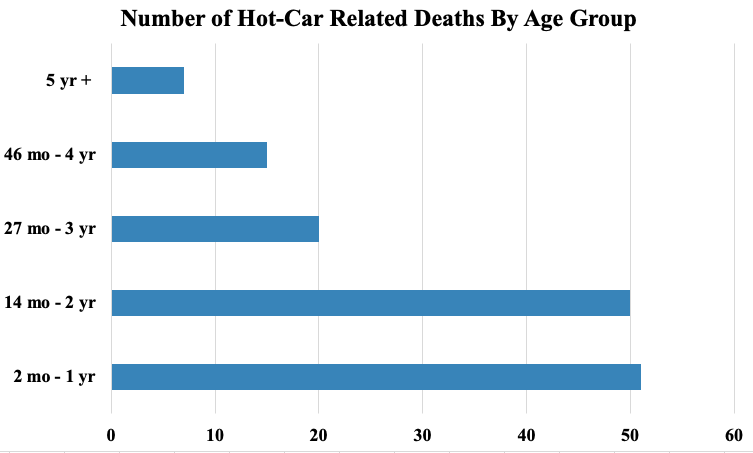
| Age | Deaths |
|---|---|
| 2 mo – 1 yr | 51 |
| 14 mo – 2 yr | 50 |
| 27 mo – 3 yr | 20 |
| 46 mo – 4 yr | 15 |
| 5 yr + | 7 |
Unsurprisingly, children under the age of two have the highest fatality rates, as compared to older children. In total, 101 out of 144 deaths that have happened in cars have been children under the age of two, which equates to 69% of all hot car deaths.
It’s also important to note that a child’s internal body temperature rises three to five times faster than an adults. Additionally, a child can die when their internal body temperature reaches 107 degrees.
You might also be wondering, “What was the outside temperature when these parents may have left their loved one in the car?”
Here’s what the data from the National Safety Council tells us:
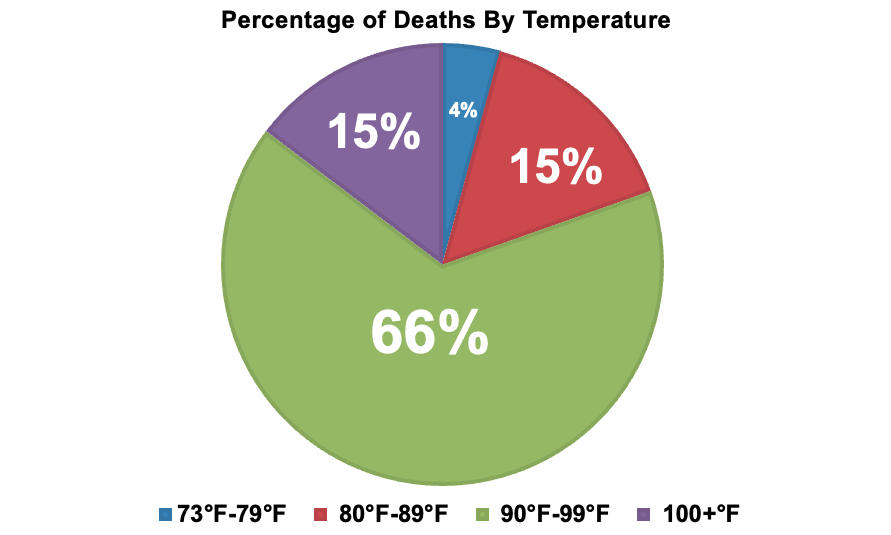
| Temperature | Deaths |
|---|---|
| 73°F-79°F | 6 |
| 80°F-89°F | 22 |
| 90°F-99°F | 94 |
| 100+°F | 21 |
You might also ask yourself the question, “Is there a correlation between higher temperatures outside and a higher amount of deaths?”. The answer is yes.
There is a clear correlation between the temperature outside and the amount of deaths that occur when someone is left inside a motor vehicle in the blazing heat.
Based upon this data, over 81% of all hot car related deaths in Texas occur when the temperature is over 90°F.
According to Texas Penal Code Chapter 22.10:
“Sec. 22.10. LEAVING A CHILD IN A VEHICLE. (a) A person commits an offense if he intentionally or knowingly leaves a child in a motor vehicle for longer than five minutes, knowing that the child is:
(1) younger than seven years of age; and
(2) not attended by an individual in the vehicle who is 14 years of age or older.
(b) An offense under this section is a Class C misdemeanor.”
Based upon this law, it can result in a fine up to $500 and a Class C misdemeanor, which stays on your record for a minimum of 180 days after the date of the arrest.
With the dangers of the heat approaching, it’s important to take the following steps to keep your children safe when driving in hot temperatures.
By following these steps, you can keep your children safe and prepared to make sure a tragic event never happens. If you or a loved one has been injured, get in touch with an Austin personal injury lawyer from the Bonilla Law Firm today.
For this study, we drew upon data from the National Safety Council, noheatstroke.org, a program supported by the National Safety Council, and the National Highway Traffic Safety Administration (NHTSA).
After reviewing the data from those sources, we then analyzed the data via Excel and created the necessary data tables and charts.
If you are a journalist or reporter and you would like to use any of the findings from this study, please provide a link back to this page.